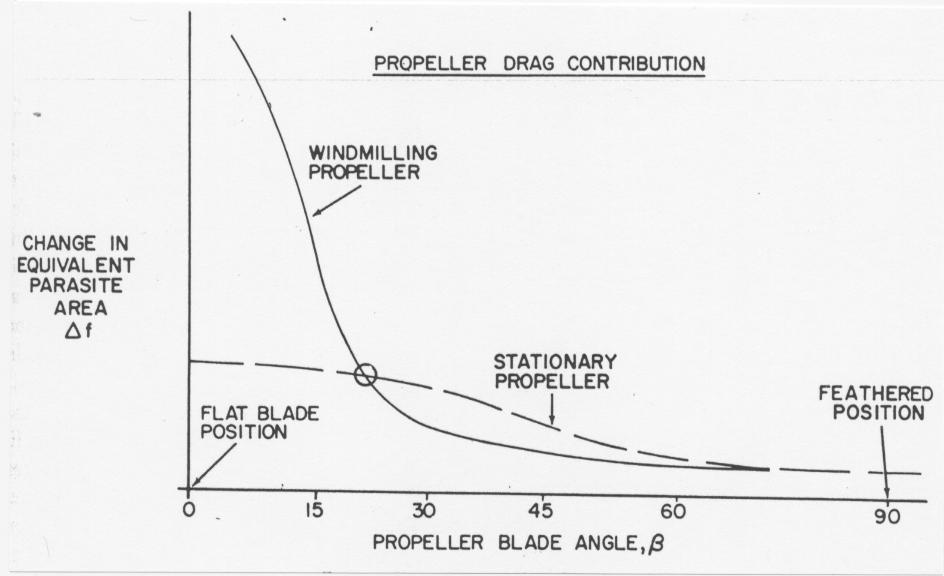I changed the subject because the topic changed........... In
response to Bill Kennedy
Bill,
Learning how to glide and the kind of prop used does matter.
Why? Any Lancair is a slick plane and, as such, has a very low drag
coefficient. Thus, any other component of drag has a significant
performance effect. The prop is such a component.
The best glide speed range should be known and it is the target air
speed after any engine mishap where the engine cannot be restarted. Those
aircraft equipped with an AOA device probably have a indication of best
glide regardless of aircraft loading.
After achieving best glide, the next concern is rate of descent - a rate
that is significantly affected by drag. The prop pitch position
and movement create greatly different levels of drag. Thus, the
following conditions should be examined: prop pitch and windmilling or stopped
(whether the engine seized or a maneuver was used to stop the prop).
Consider the chart extracted from "Aerodynamics for Naval Aviators:"

Consider Constant Speed props first (prop pitch,windmilling). For
example, the Hartzell CS prop for a Lyc 320 has a flat pitch limit of 12 degrees
and a coarse pitch limit of 40 degrees. Using the chart above one can see
that at 12 degrees, the windmilling prop has a great deal of drag while at 40
degrees the drag component is not much greater than that of a feathered
prop. The 40 degree position probably allows the prop to continue turning,
thus keeping the pitch management oil pressure up. And once the prop
control is pulled to coarse pitch, as Bill Harrelson suggested, one should open
the throttle to reduce engine intake stroke drag. In my 320, the
0-thrust (engine approximately at idle) descent rate at best glide
(about 107 KIAS) goes from 1500 fpm at cruise pitch to about 500 fpm at
coarse pitch.
A fixed pitch prop that is windmilling contributes a great deal of
drag (look up the cruise pitch on the chart). One should consider
stopping the prop by leaving the throttle closed and carefully perform a
climb maneuver (without a stall) to try to stop the prop from turning if the
engine is not restartable.
If the prop is stopped, whether by maneuver or seizure, the drag is
certainly less than a prop in cruise pitch that is windmilling.
Note that the aircraft performance (or lack thereof) of a stopped
CS at flat pitch or fixed pitch prop at cruise pitch probably favors
the fixed pitch prop.
Of course, the best engine failure performance condition is that
with a feathered prop.
Relatively speaking, remember that a C172, with its rivets, struts and
wheels all contributing to drag, is less affected by drag from the prop in a
failed engine condition.
Scott Krueger AKA Grayhawk
In a message dated 12/17/2009 8:37:56 A.M. Central Standard Time,
bill_kennedy_3@hotmail.com writes:
If you
really want cheap insurance, learn how to glide and make a power off landing.
Glide performance in a spin is really poor and the landing is no better
(always fatal as far as I know). The kind of prop doesn't really matter. The
pilot should be able to tell pretty quickly whether he can make a field or
not, certainly 7,000 feet gives you plenty of time to analyze your glide. If
you can't make it to the spot you want, land in a field. Airmanship is the
best insurance I can think of.
> To: lml@lancaironline.net
>
Date: Tue, 15 Dec 2009 16:33:59 -0500
> From:
farnsworth@charter.net
> Subject: [LML] Re: Legacy Crash
Watsonville?
>
>
>
> It is my understanding that
the crash occurred close to the airport. I think
> I read it was about 1
mile. If that is true I think that the glide range
> difference between
a standard constant speed prop and a feathering prop
> would have made
the difference between making the airport and not.
>
> I believe
it was reported that the pilot said he was at 7,000' when the
> problem
occurred. The fact that he made it to within 1 mile of a safe
> landing
with a standard prop (I don't know if he pulled his prop control
> back
of not. I think the engine was not turning at the time of ground
>
contact.)is evidence that the higher glide ratio of the feathering
prop
> would have extended his range enough to land at the airport. With
loss of
> oil pressure the feathering prop I have in my plane feathers
automatically.
> It does not require me to pull the prop control
back.
>
> Three years ago, at the Reno Air Races, Lee Behel was
flying his Legacy in
> the valley to the West of Stead when he had an
engine failure. It was touch
> and go on whether he would have an off
airport landing or not. The
> difference was the feathering prop on his
plane. If he had had a standard
> prop he would not have made the
airport for an uneventful landing.
>
> I just think a feathering
prop is cheap insurance.
>
> >
> > Lynn
Farnsworth
> > Super Legacy #235
> > TSIO-550
Powered
> > Race #44
> > Mmo .6 Mach
> > Feathering
Prop
>
>
> --
>
>
> --
> For
archives and unsub
http://mail.lancaironline.net:81/lists/lml/List.html
=